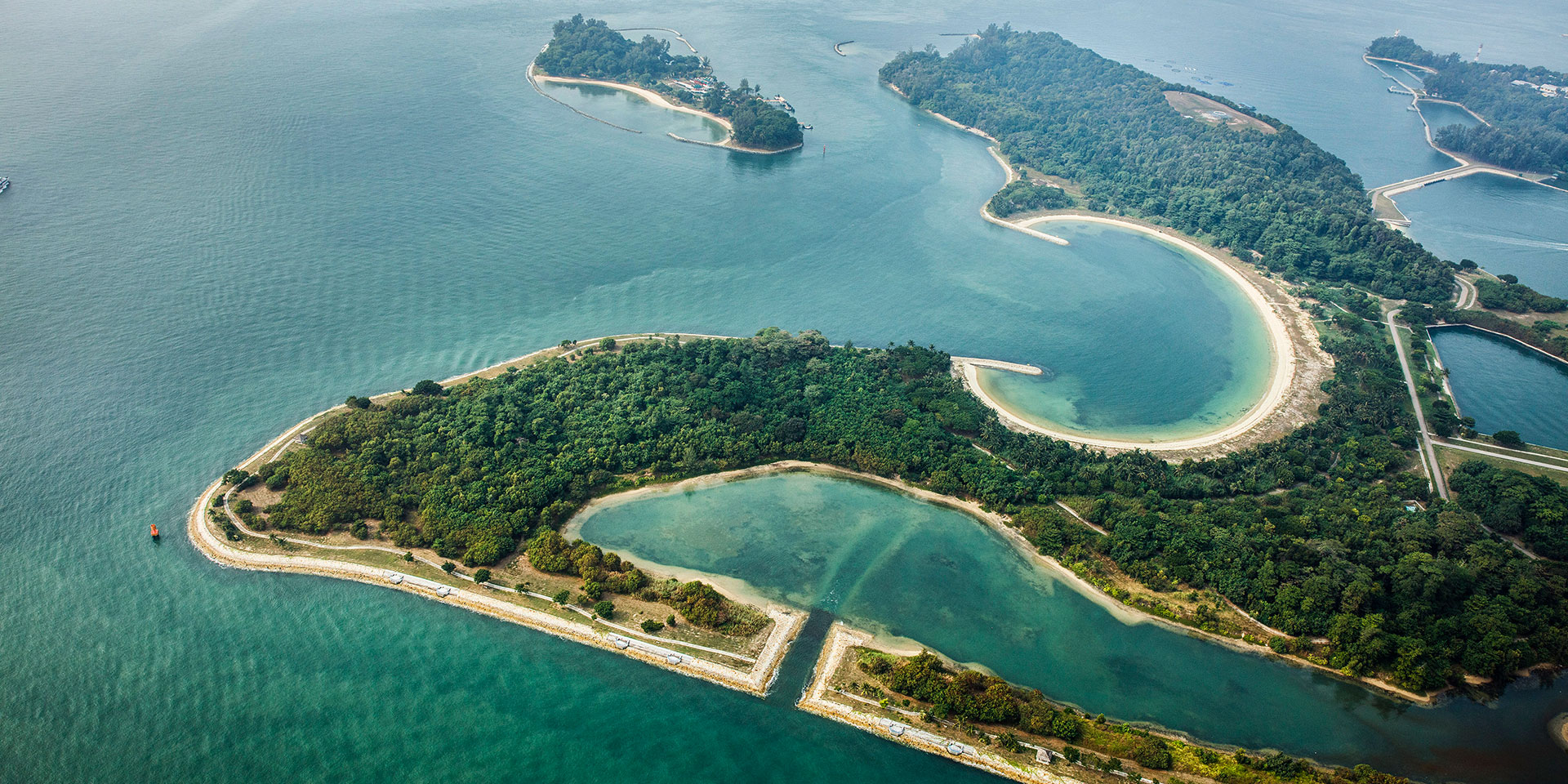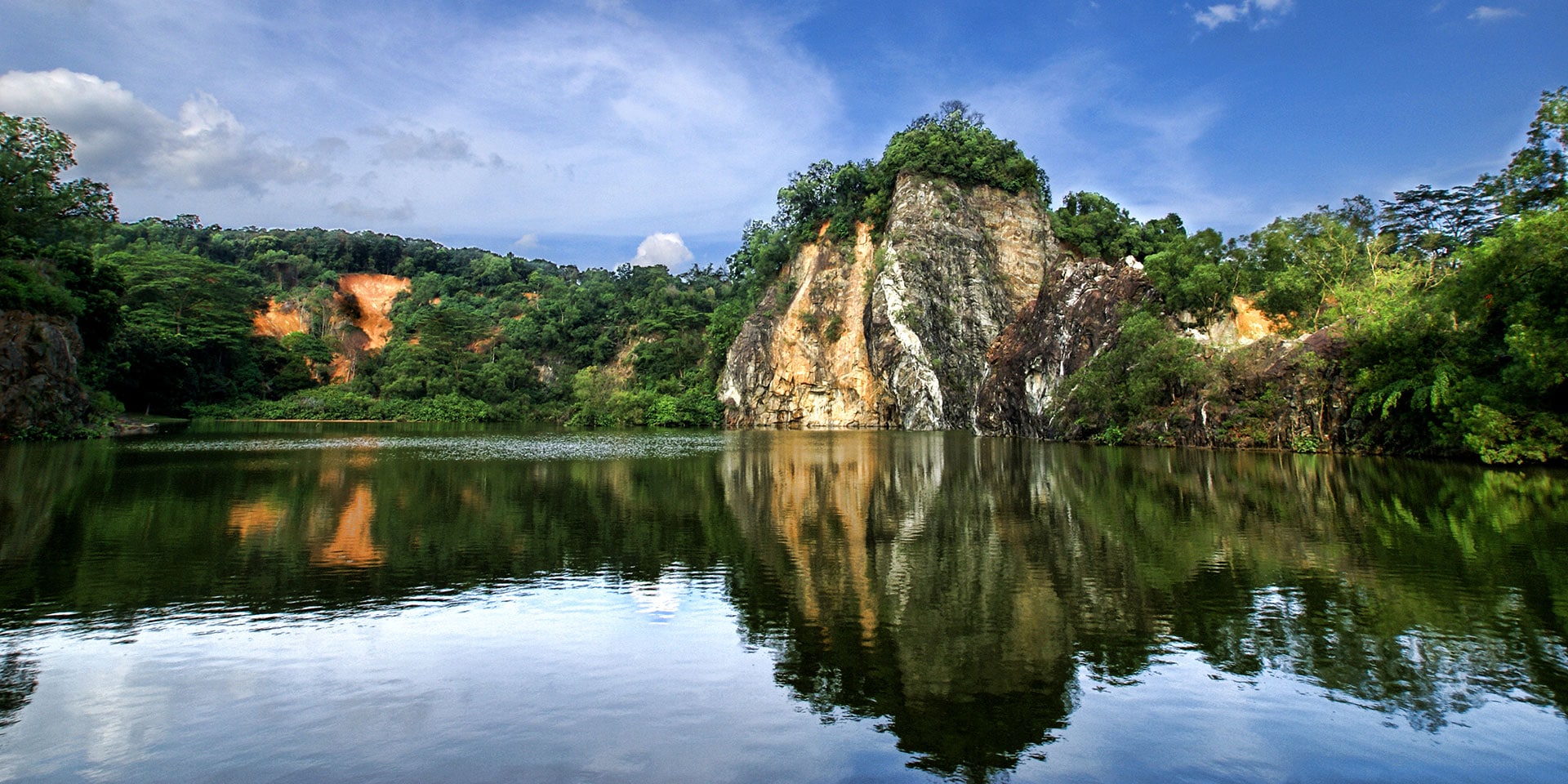In busy city-state Singapore, speedy trains and buses carry streams of workers en masse to their daily grind. Yet just minutes away from this daily hubbub you can rejoice in some of life’s simple pleasures: a forest hike, a splash of hot-spring water and farm-to-table food.
As always, check for travel guidelines and closures before planning your trip.
Little Guilin
Wend your way through a cluster of public housing flats in suburban west Singapore and you’ll come across a sight to behold: the 42-hectare Bukit Batok Town Park. More affectionately known by locals as Little Guilin, it was formed from a disused granite quarry and looks similar to the granite rock formations in China’s Guilin province.
A majestic granite rock sits in the middle of a still lake, and if you look really closely, turtles bob their heads as they take a leisurely swim. The park is separated into two parts by a small granite rock hill, which used to be climbable but has been blocked off for some time (coincidentally, perhaps, behind the quarry is Singapore’s defense ministry headquarters).
Instead, sit in one of two domed shelters and while your time away marveling at the largely untouched surroundings. Here you will spot joggers, as well as shutterbugs looking to capture nature’s finest or a couple’s love in a wedding photo shoot.
If you’re looking for a secluded spot, go to the left of the bank and climb up the stairs, which will then descend down to a small clearing right next to the lake. Just remember: fishing is prohibited here.
Getting there: Little Guilin is a five-minute walk from Bukit Gombak train station—just circle the right side of the stadium out front and follow where the eyes lead.
Sembawang Hot Spring
Tucked between army camps and an airbase in Sembawang, in northernmost Singapore, is the city’s only hot spring. The smell of sulphur wafts in the air as water from the hot spring flows freely from the taps (signs here request that the taps not be turned off).
Bring a bucket: this is not your typical hot-spring-with-luxury-lagoons ready for you to drop your trousers and take the plunge. It’s a manual process of collecting water, picking your spot around the small confines of the sparse, fenced-in zone and soaking your feet in your bucket to relax muscles and joints.
Why make the trip? The water is found to have three times more sulfide than tap water and is believed to have medicinal properties.
There’s a catch to visiting the hot spring, though: the Singaporean government recently debated plans to turn this place into a national park (the land is currently under the defense ministry). While nothing has been decided just yet, now’s your chance to visit this rustic, hidden gem before the taps truly turn off for good.
Getting there: From Admiralty train station take bus 969 from Woodlands Avenue 7. Alight outside Block 114 at Sembawang Road, and it’s a 5-minute walk to Jalan Ulu Sembawang.

Pulau Seringat
Many of Singapore’s little islands are very popular and get crowded at weekends. But venture beyond the beaches of Sentosa Island to the southerly St John’s Island. This is still not your final destination, for here there’s a small bridge connecting to neighboring Lazarus Island and then it’s a short walk to Pulau Seringat, an oft-forgotten isle that’s populated by wildlife.
This enclave is a standing example of unvarnished beauty, despite reclamation efforts to create man-made lagoons. During low tide, spot signs of marine life on the beaches including sea anemone, moon snails and starfish. The surrounding mangrove trees also provide a nice backdrop when the roots are exposed.
This island is the most untouched out of the Southern Islands accessible via ferry, so feel free to frolic amid the tall grass and lush greenery. But remember to bring food and drinks—there are no shops in the area.
Tourism projects have been proposed for the Southern Islands which include plans for integrated resorts, but the government has not acted on them yet, so for now the island remains an untouched beauty.
Getting there: A round-trip ferry to St John’s Island from Marina South Pier costs S$18.
Puaka Hill
The offshore rustic island Pulau Ubin, located between Singapore and Malaysia in the Johore Strait, is commonly sought out for its prized Chek Jawa Wetlands. But take a detour to the other side of the island for a little-known forested hiking trail up Puaka Hill, Ubin’s highest point.
From the ferry terminal, rent a bike for a nominal fee and pedal past Jelutong Bridge until you see a small clearing next to Merbah Hut where you can park the bike. Trekking Puaka Hill is a steep 30-minute climb that navigates thick forest and rocky soil, but the journey to the top is worth it for the panoramic views out over the gorgeous lake (the former Ubin granite quarry).
It is a sight to behold on a clear day, with the horizon stretching all the way to Singapore’s business district and parts of neighboring Malaysia.
Getting there: Pulau Ubin is accessible via the Changi Point Ferry Terminal—take a 10-minute bumboat out (hold on because it can get bumpy sometimes) and then hire a bike.
Bollywood Farms
Agriculture may form less than 0.5% of Singapore’s economy, but it does not feel that way out here in the Kranji countryside, where lush fields stretch as far as the eyes can see. Among the collection of farms in the area, one stands out for its quirky signs: Bollywood Farms, so named after owner Ivy Singh-Lim’s Indian heritage.
“Welcome to Paradise” greets you at the gate. More tongue-in-cheek signs such as”Make Gardens Not War” and “Back to Nature Is the Future” reveal this self-sustaining farm’s certain rebellious side. Some 10 acres of land cultivate a wide variety of flora and fauna, all grown without pesticides or fertilizers.
You can pick small flowers and leaves but not the fruits—these will be harvested by the farmers, with some used at their farm-to-table bistro Poison Ivy in delicacies such as chicken curry and nasi lemak (coconut rice with chicken and anchovies).
If you’re traveling in big groups, the staff will assist in organizing tours to the museum where a series of paintings reveal the history of food. Spot the two dogs roaming the farm—the female one is particularly shy.
Getting there: Hop on the shuttle bus from Kranji MRT Station toward the Kranji countryside.




